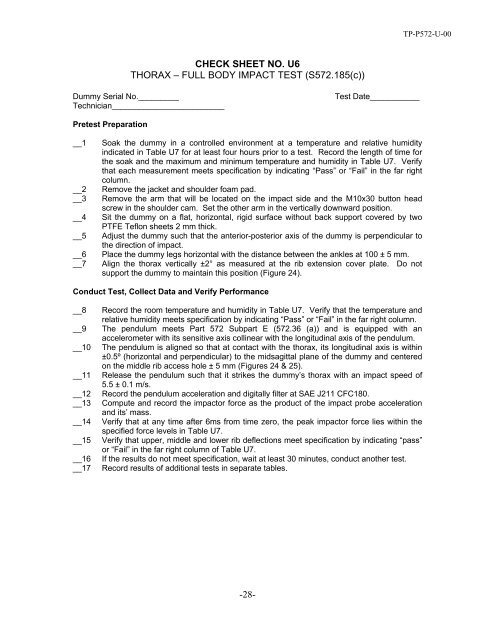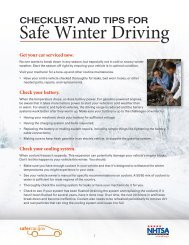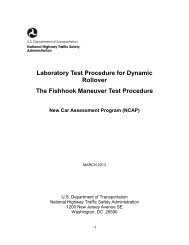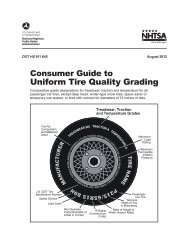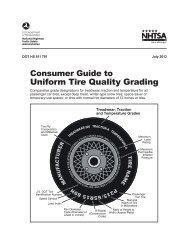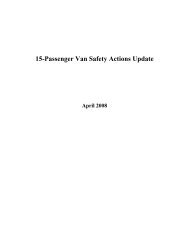U.S. DEPARTMENT OF TRANSPORTATION - SaferCar.gov
U.S. DEPARTMENT OF TRANSPORTATION - SaferCar.gov
U.S. DEPARTMENT OF TRANSPORTATION - SaferCar.gov
Create successful ePaper yourself
Turn your PDF publications into a flip-book with our unique Google optimized e-Paper software.
TP-P572-U-00<br />
CHECK SHEET NO. U6<br />
THORAX – FULL BODY IMPACT TEST (S572.185(c))<br />
Dummy Serial No._________<br />
Technician_________________________<br />
Test Date___________<br />
Pretest Preparation<br />
__1<br />
__2<br />
__3<br />
__4<br />
__5<br />
__6<br />
__7<br />
Soak the dummy in a controlled environment at a temperature and relative humidity<br />
indicated in Table U7 for at least four hours prior to a test. Record the length of time for<br />
the soak and the maximum and minimum temperature and humidity in Table U7. Verify<br />
that each measurement meets specification by indicating “Pass” or “Fail” in the far right<br />
column.<br />
Remove the jacket and shoulder foam pad.<br />
Remove the arm that will be located on the impact side and the M10x30 button head<br />
screw in the shoulder cam. Set the other arm in the vertically downward position.<br />
Sit the dummy on a flat, horizontal, rigid surface without back support covered by two<br />
PTFE Teflon sheets 2 mm thick.<br />
Adjust the dummy such that the anterior-posterior axis of the dummy is perpendicular to<br />
the direction of impact.<br />
Place the dummy legs horizontal with the distance between the ankles at 100 ± 5 mm.<br />
Align the thorax vertically ±2° as measured at the rib extension cover plate. Do not<br />
support the dummy to maintain this position (Figure 24).<br />
Conduct Test, Collect Data and Verify Performance<br />
__8<br />
__9<br />
__10<br />
__11<br />
__12<br />
__13<br />
__14<br />
__15<br />
__16<br />
__17<br />
Record the room temperature and humidity in Table U7. Verify that the temperature and<br />
relative humidity meets specification by indicating “Pass” or “Fail” in the far right column.<br />
The pendulum meets Part 572 Subpart E (572.36 (a)) and is equipped with an<br />
accelerometer with its sensitive axis collinear with the longitudinal axis of the pendulum.<br />
The pendulum is aligned so that at contact with the thorax, its longitudinal axis is within<br />
±0.5º (horizontal and perpendicular) to the midsagittal plane of the dummy and centered<br />
on the middle rib access hole ± 5 mm (Figures 24 & 25).<br />
Release the pendulum such that it strikes the dummy’s thorax with an impact speed of<br />
5.5 ± 0.1 m/s.<br />
Record the pendulum acceleration and digitally filter at SAE J211 CFC180.<br />
Compute and record the impactor force as the product of the impact probe acceleration<br />
and its’ mass.<br />
Verify that at any time after 6ms from time zero, the peak impactor force lies within the<br />
specified force levels in Table U7.<br />
Verify that upper, middle and lower rib deflections meet specification by indicating “pass”<br />
or “Fail” in the far right column of Table U7.<br />
If the results do not meet specification, wait at least 30 minutes, conduct another test.<br />
Record results of additional tests in separate tables.<br />
-28-


